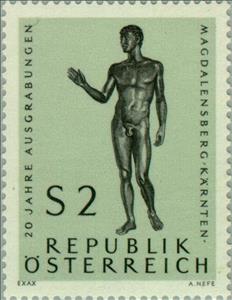Stamp: Young man of Helenenberg, copy of Greek bronze statue (Austria 1968)
Young man of Helenenberg, copy of Greek bronze statue (Austria 1968)
15 July (Austria ) within release Excavation Magdalensberg (Kärnten) goes into circulation Stamp Young man of Helenenberg, copy of Greek bronze statue face value 2 Austrian schilling
| Stamp Young man of Helenenberg, copy of Greek bronze statue in catalogues | |
|---|---|
| Michel: | Mi:AT 1268 |
| Yvert et Tellier: | Yt:AT 1099 |
Stamp is vertical format.
Stamp Young man of Helenenberg, copy of Greek bronze statue it reflects the thematic directions:
Sculpture is the branch of the visual arts that operates in three dimensions. Sculpture is the three-dimensional art work which is physically presented in the dimensions of height, width and depth. It is one of the plastic arts. Durable sculptural processes originally used carving (the removal of material) and modelling (the addition of material, as clay), in stone, metal, ceramics, wood and other materials but, since Modernism, there has been almost complete freedom of materials and process. A wide variety of materials may be worked by removal such as carving, assembled by welding or modelling, or moulded or cast.
A statue is a free-standing sculpture in which the realistic, full-length figures of persons or animals are carved or cast in a durable material such as wood, metal or stone. Typical statues are life-sized or close to life-size. A sculpture that represents persons or animals in full figure, but that is small enough to lift and carry is a statuette or figurine, whilst those that are more than twice life-size are regarded as colossal statues.
Archaeology or archeology[a] is the study of human activity through the recovery and analysis of material culture. The archaeological record consists of artifacts, architecture, biofacts or ecofacts, sites, and cultural landscapes. Archaeology can be considered both a social science and a branch of the humanities. It is usually considered an independent academic discipline, but may also be classified as part of anthropology (in North America – the four-field approach), history or geography


